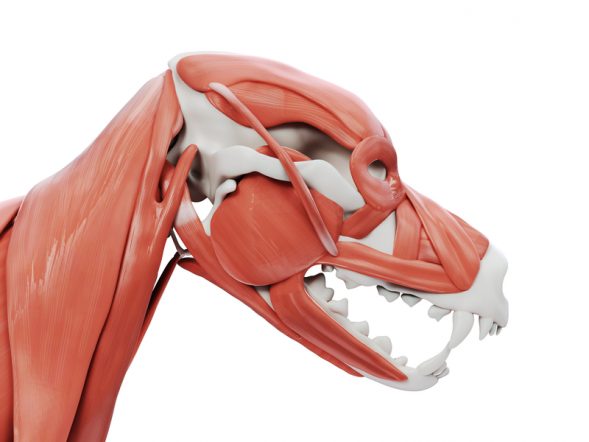
Much of the time, the term “fleshy” is used to describe a dog’s paws or ears, but when used to explain a dog’s face, it usually means there’s an abundance of “fill” on a dog’s cheek.
Cheeks are small on a dog because of the large mouth opening, but when they’re “cheeky” or “fleshy,” it’s not because there’s a lot of skin, but because there’s a greater degree of cheek muscle than is desired for that breed. Specifically, “fleshy” means there are well developed masseter muscles, the muscles that are used to raise the dog’s mandible and close its jaw.
Breeds that kill their prey by snapping, like many terriers, and dogs that retrieve game with a soft mouth, have poorly developed masseter muscles. Conversely, when a breed standard like that of the American Staffordshire Terrier, calls for very pronounced cheek muscles, what it’s really asking for are well developed masseter muscles because this is a breed that holds its prey, and that takes strong muscles. This also applies to another terrier, the American Hairless Terrier, which should have well-muscled cheeks. Consider how a Newfoundland rescues a swimmer in distress. They use their mouth to grab an arm or bit of clothing, right? This explains why this breed’s standard calls for cheeks that are well developed.
Interesting, the Smooth Fox Terrier standard stipulates that the cheeks must not be full, and while the breed has strong and powerful jaws, perhaps this was, in part, because the breed’s function was to bolt foxes. The Wire Fox Terrier standard nicely provides more data: “…an excessive bony or muscular development of the jaws is both unnecessary and unsightly, as it is partly responsible for the full and rounded contour of the cheeks to which the term “cheeky” is applied.” The Irish Terrier standard also spells this out: “Excessive muscular development of the cheeks, or bony development of the temples, conditions which are described by the fancier as “cheeky,” or “strong in head,” or “thick in skull” are objectionable.” Another breed with a lean head is the Irish Terrier: “The cheeks flat and smooth as possible.” Other terriers with “flat” cheeks: The Scottish Terrier, Rat Terrier, Sealyham Terrier, and Welsh Terrier. By no means is the term, “flat” limited to terriers. The Chihuahua standard calls for flat cheeks as do the standards of the Doberman Pinscher, Toy Poodle, Boxer, Toy Fox Terrier, Azawakh, Great Pyrenees, German Pinscher, Kuvasz,Giant Schnauzer, and Cirneco Dell’Etna. The Portuguese Podengo Pequeno, Spinone Italiano, and Portuguese Podengo should have “lean” cheeks.
The Manchester Terrier should have no visible cheek muscles, but the Boerboel has well filled cheeks, and the Chinook’s cheeks should be well-developed.
In the world of sporting breeds, some standards also call for “flat’ cheeks (like the Lagotto Romagnolo, English Springer Spaniel, the Nova Scotia Duck Tolling Retriever), or that there be a lack of being “cheeky” (the Curly-Coated Retriever). Others ask that the breed be free from exaggeration of the cheek (the Flat-Coated Retriever), to have cheeks that present a smooth and clean-cut appearance (the English Setter), to have no prominence in the cheeks (the Cocker Spaniel), or to be straight and clean (the Field Spaniel).
Only one breed standard in all of the AKC breeds, not just sporting breeds, stipulates that the head should be clean-cut and free from fleshy cheeks, and that standard belongs to the Labrador Retriever. Only one other breed standard mentions “fleshy” with regards to the cheeks at all, and that belongs to the Dogue de Bordeaux: “Muzzle – Powerful, broad, thick, and rather short. Should not be fleshy below the eyes.”
More than you may have ever wanted to know about cheeks!
Image by © Sebastian Kaulitzki/Dreamstime.com

Years ago while doing a deep dive into the standard for my breed, the Airedale Terrier, I researched the muscles of the head. The standard calls for a flat skull and cheeks free from fullness. What I learned, and analyzed, recognizing that I am an amateur, is that there are two main muscles that close and move the jaw. The temporalis attaches on the top of the skull and the mandible. It is a big muscle and it’s only function is to close the jaw. It passes through the zygomatic arch.The Airedale’s skull is flat because the temporalis is large and fills in around the occipital crest. You know how hard it is to open a dog’s closed mouth if it doesn’t want you to. That is the temporalis.
The masseter muscles are the cheek muscles and they attach to the bottom of the zygomatic arch and the mandible. It helps close the jaw but it main function is to move the jaw from side to side, to chew, think massication.
Most of the hunting terriers kill their prey by grabbing and shaking. So they have very powerful temporalis muscles to hold tight while shaking. They don’t chew the prey, so the masseter muscles are not large and their cheeks are flat. Flat cheeks are also desirable in breeds that should have soft mouths, alson with less developed temporalis muscles, creating the chiseled heads seen in many sporting dogs.
On the other hand, breeds with a history of dog fighting or holding large prey for the hunter have powerful masseter muscles. They grab hold and chew in order to inflict as much damage as possible.
A website describing these structures is at https://mediaspace.msu.edu/media/VM+525-Muscles+of+the+head+of+the+dog+and+cat+%28dissection+video%29/1_gyr0ata7. WARNING, it has a video showing dissections of dog heads. The narration is printed in a text box below the video. You might want to scroll to the point where you can read the text without seeing the video if you are squeamish.